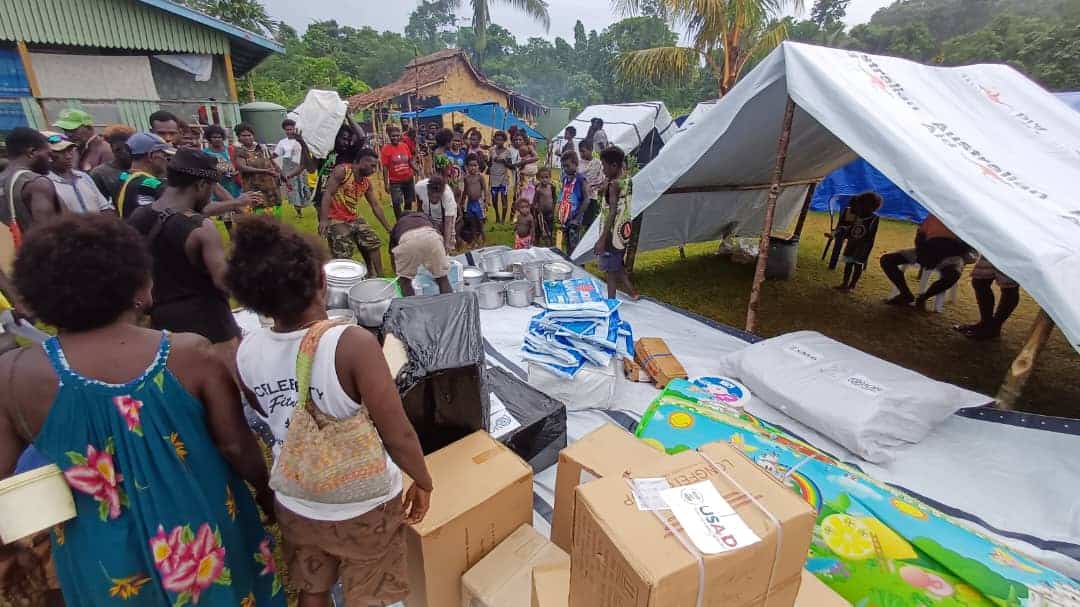Several thousand people remain in limbo three months after the eruption of Papua New Guinea’s Mt Ulawun, living at muddy camps euphemistically named “care centres” by authorities, and increasingly unhappy about the conditions they face.
The villagers’ chances of returning to their homes around the mountain on West New Britain island have remained uncertain despite the volcano falling largely quiet in recent weeks. Papua New Guinea’s Rabaul Volcano Observatory lowered Ulawun’s alert level on 09 January but said it wasn’t completely quiet.
Two weeks ago, heavy rains caused mud, rocks and debris to slide down Mt Ulawun’s slopes, smashing through homes below the mountain, showing the continuing risks from other hazards.
Blaise Luveni, a local government councillor, said the displaced people need food supplies to be more consistent, goods such as water tanks, stronger canvases to keep the rain out of shelters, as well as hygiene items such as soap and toilet paper.
“Food rations of rice and tin fish are inconsistent. The tents given to us cannot hold (up against) the heavy wind and rain leaking into our tents resulting in families sleeping in wet clothes and bedding,” Luveni said in an interview.
BenarNews visited two of the makeshift camps – Sogula and Kabaya – near the village of Ulamona, which is about 10 kilometers from the volcano. Conditions are difficult due to the rainy season and the flimsy structures people are living in. Elderly women were digging drains around their tents in an effort to stop their beds from being inundated.
“We cannot sleep fearing the wind and rain will remove our tents. Most of us sleep in wet clothes on wet blankets,” said Juliana Saeke at the Sogula camp.
Luveni told Benar News that he was concerned government officials, including the provincial disaster director, were not conducting regular checks at the camps.
“The 10-day ration is not sufficient, there is only rice and tin fish. There is no soap in the rations, no toilet paper or baby diapers and not enough toilets built,” said Bertha Saea, a mother living with her children at Sogula.
In early February, Australia’s air force airlifted 16 tons of humanitarian aid, donated by India, from the capital Port Moresby to West New Britain and it is now stored at Kimbe, about 100 kilometers from the camps.
It’s unclear when the aid will be distributed, likely because of limited transport options. It sat in Port Moresby for about a month before a plane was available to deliver it to West New Britain.
In response to concerns raised by the displaced people, Clement Bailey, director of the provincial disaster office, said they were being looked after.
“We are providing food rations. The ratio is one bag of rice for 10 days. We cannot provide everything. We cannot be picky about everything and [should] learn to accept what is given to us,” he told BenarNews.
“We are providing the basics and will not bow down to every demand.”
Bailey said a technical team would visit a damaged seismic station closest to Mt. Ulawun for repairs, which could provide the assurance needed for people to move back to the area.
Some women at the camps said they were ready to visit their homes to gather food from their gardens but there was no transport to get there. They said they also fear mud slides during the current rainy season so were cautious about returning.
Gregory Paulu, the leader of the Kabaya camp, said the province’s disaster committee should develop a restoration and resettlement plan and consider moving the camps to higher ground in the meantime.
Other camps established by palm oil plantation company Hargy for employees affected by the eruption were likely to be dismantled soon, said general manager Craig Gibson.
The longer the “care centres” stay, with large groups of people in small areas, the higher the risk of discontent, possible disease outbreaks and breakdown of law and order, he told BenarNews. About 6,000 hectares (14,826 acres) of the company’s oil palms were affected by the eruption, with losses estimated at K50 million (US$13 million), Gibson said. The weight of the ash caused palm fronds to collapse, which is now making it difficult to salvage the fruit, he said.
